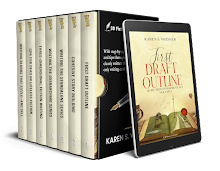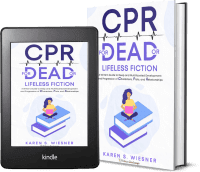Oldies But Goodies
{Put This One on Your TBR List}
Book Review: Relic
and Reliquary by Douglas Preston and
Lincoln Child
by Karen S. Wiesner

Be aware
that there may be spoilers in this review.
Relic (which is the original
title the authors prefer, not the 1997 movie title of "The" Relic which actually did make it to several
versions of the book) was written by Douglas Preston and Lincoln Child and was
published in 1995 as the debut collaboration by two authors who write separate
masterpieces on their own. The authors' website includes information about how
they met--via the museum Preston worked and Child, an editor at St. Martin's
Press, was so fascinated by that he commissioned a book about its history. They've
included very interesting histories and stories behind all of their works on
their website https://www.prestonchild.com/
which is definitely worth a look. The sequel, Reliquary, was published in 1997. Classified as horror
technothrillers, a genre creation that's predominately credited to Michael
Crichton, reviews actually likened the premiere book to a story where a
dinosaur-like creature gets loose in a museum. Simply defined, it is that, and
very enjoyably so.
In Relic, an expedition in the
Amazon Basin searching for a lost tribe goes horribly wrong (as they so often
do), and years later the relics discovered on that journey, along with the
journal of the leader, eventually find their way to their intended
destination--the fictional American Museum of Natural History in New York City.
The setting of the first two books of what later became The Pendergast Series
is very nearly the star of this show. As someone who was actually involved in
the inner workings of a museum similar to the one portrayed in the books,
Preston's early connection lent credulity, insight, and wonder to these two
stories. Readers are treated to the labyrinthine corridors and showcases that
fill the stories with tantalizing displays that can alternately seem informative
in the daytime and horrifying in the night, along with long forgotten treasures
from other, lesser explored worlds in secured vaults.
Additionally, inner workings of the politics and personnel within this
structure are intriguing. Naturally, once the bizarre killings begin, centered
in the museum, readers can't be sure of what's actually happening, given that
there are plenty of real-life bad guys in this setting without having to resort
to otherworldly monsters. But, lucky for all us horror fans, there actually is
an ancient beast plucked from a shrouded world roaming the maze of hallways,
secret rooms, and the long-deserted basement and sub-basement connected below
the museum.
The museum has been planning to unveil the ill-gotten findings from the
expedition that causes all the tragedy in both Relic and Reliquary in a
massively funded exhibition. The murders threaten to shut it down before
launch, which would be financially catastrophic for the museum. As a lover of
all types of these, the museum itself was one of the things I loved most about
these two books. There's a whole world there that could be explored
indefinitely. Inject horror into the equation, and I'm utterly beguiled.
The murders in the museum are investigated by NYPD Lieutenant Vincent
D'Agosta until the FBI gets involved. Initially, Special Agent Aloysius
Pendergast takes over, having an interest to the similar pattern of these
murders to others he's seen before, elsewhere. Before long, he's replaced by
another agent, Coffey, who's a complete and utter idiot. He makes a series of
bad choices that very nearly leads to disaster for the entire city. If not for
a select few, all would be lost. These heroes save the day, though not
permanently, as the story continues into a sequel in which they discover that
the horror and murders associated with the museum aren't over after all.
In terms of plot, action, and suspense, these two books have an absolute
playground of all. Like Dan Brown books, the external conflicts in the works of
not only the collaborating authors but their individually written titles as
well are filled with seemingly unending mystery and thrills--a dark side to
natural science and history. You read these books for the nonstop twists and
turns, and you're never disappointed by what you're given in that vein. In
Brown's stories in particular, I feel that the action is relentless and
exhausting, and I've been known to fall asleep in the middle of them--solely because
the author doesn't provide enough, if any, downtime. In Preston and Child's
books, it isn't quite that extreme, but the plot-heavy stories tend to run in
that direction more often than not. Characters and readers alike desperately
need downtimes in order to catch their breath so they can continue engaging in
fast-paced stories like these. That's where I'm convinced these authors fall
just a little bit short (Brown mostly, not as much with the others mentioned).
Additionally, deep characterization in books of these types is generally
poor. In Relic and Reliquary, most of the characters are
only mildly compelling. Almost entirely because they showed up the most, the
ones that made at least vague impressions are D'Agosta; Special Agent Pendergast;
Margo Green, a graduate student at the museum, and Dr. Frock, her advisor and a
department head there; along with Bill Smithback, Jr., a journalist who's been
hired by the museum to writing a book about the upcoming exhibition. Smithback
and Pendergast make appearances in a variety of the collaborative authors'
works, not always in the same series. For instance, Smithback returns in the
Nora Kelly (a renowned archaeologist Smithback eventually marries) Series, as
well as more than a few of the Pendergast Series books. His tragic history is
chronicled on the following website, https://prestonchild.fandom.com/wiki/Bill_Smithback,
for those who are curious about him, but be aware that his character was cut from
the movie version of Relic, which is
kind of inconceivable to me, if for no other reason but that he was a great
comic relief (and the favorite of the authors themselves). To give you an
example, during one tense moment where the museum beast is wreaking havoc in another
area of the exhibition, Smithback has free access to the tantalizingly fine
spread the museum has laid out for those who show up for their new exhibit. He gorges
himself without inhibition. Okay, so it's in poor taste (excuse the pun), given
the extenuating circumstances, but it was also just the comic relief needed in
this situation. Of all the characters included in these two books, Smithback
was the one who received most of the fleshing out, and I enjoyed several of his
other appearances in the two authors' other works as well.
On the subject of characterization, in my point of view, whipsaw
thrillers that are more focused on plot tend to have the characters necessary manufactured
on the fly within the story. They fill the roles they're intended to occupy for
the moment, then they disappear altogether or, rarely, make minor returns to
the story in random other scenes. Relic
and Reliquary are very nearly smothered
under the weight of so many point of view characters that enter the story only
to die or pass almost unceremoniously out of the book in the same scene. It's
very hard to choose who was actually the main character in either of these
books--I suppose D'Agosta, Margo, or Smithback come the closest but I wouldn't
say that definitively. For each, we learn a few things that were probably
listed on a characterization worksheet about them, little or nothing personal
that doesn’t pertain to the immediate story, and any internal conflict is
almost always directly related to the external conflict. As two examples of
that:
In Relic, D'Agosta relates something about his own son in direct
correspondence with the horrific murder of two children at the beginning. We
learn precious little beyond that of the police detective's personal life.
Also in Relic, Margo Green's father supposedly just died. At no point in
either books are we privy to feelings of loss or grief in this character about
that fact (and that was what it felt like--a mere factoid). Little more is said
except Margo's single thought about really, really not wanting to go home to
take over the family business legacy her father's death leaves to her.
I guess the best that can be said in books of these types is that
characters are meant to serve a purpose. No more. No less. And that's the end
of that. But I admittedly prefer much deeper characterization than providing a
convenient face to hang the external conflicts in the story on.
Another character I feel I have to mention because he got a whole book
series devoted to him from these two authors is Pendergast. Back in 2016, a
potential TV adaptation featuring Pendergast was being tossed around but it was
announced early in 2017 that it'd been canceled. I will note here that his
character was combined with that of D'Agosta's in the movie version and was completely
written out of the story. Further irony is that he spawned a series of more
than twenty books, and yet the authors initially found him to be "a
pompous windbag, pontificating to Margo about 'compartmentalization of labor'
and 'extended similes'." I actually liked him in Relic and Reliquary, but
when I tried to follow him into his own series with The Cabinet of Curiosities (published in 2001), where he became
more of what readers could expect of him as the main character of the series, I
found it much harder to get into the stories. I did read several of them and
intend to try again reading all of them. Let's see how far I get this time and
whether I'll feel compelled to write reviews of them.
Other than the superficial characterization you can expect in these two
books (and many of their others), there's a lot to love in Relic and Reliquary, especially
if you're looking for edge-of-your-seat beastie scares set in a wonderfully
creepy environment. I also recommend the movie.
Next week, I'll review another Oldie But Goodie you might find worth
another read, too.
Karen Wiesner is an
award-winning, multi-genre author of over 150 titles and 16 series.
Visit her website here: https://karenwiesner.weebly.com/
and https://karenwiesner.weebly.com/karens-quill-blog
Find out more about her books
and see her art here: http://www.facebook.com/KarenWiesnerAuthor
Visit her publisher here: https://www.writers-exchange.com/Karen-Wiesner/

















































